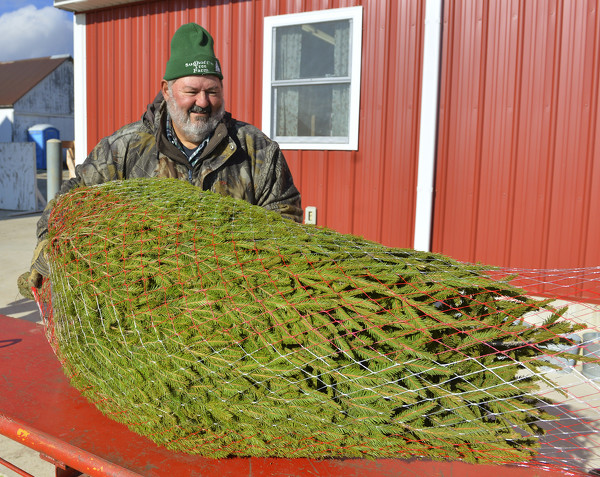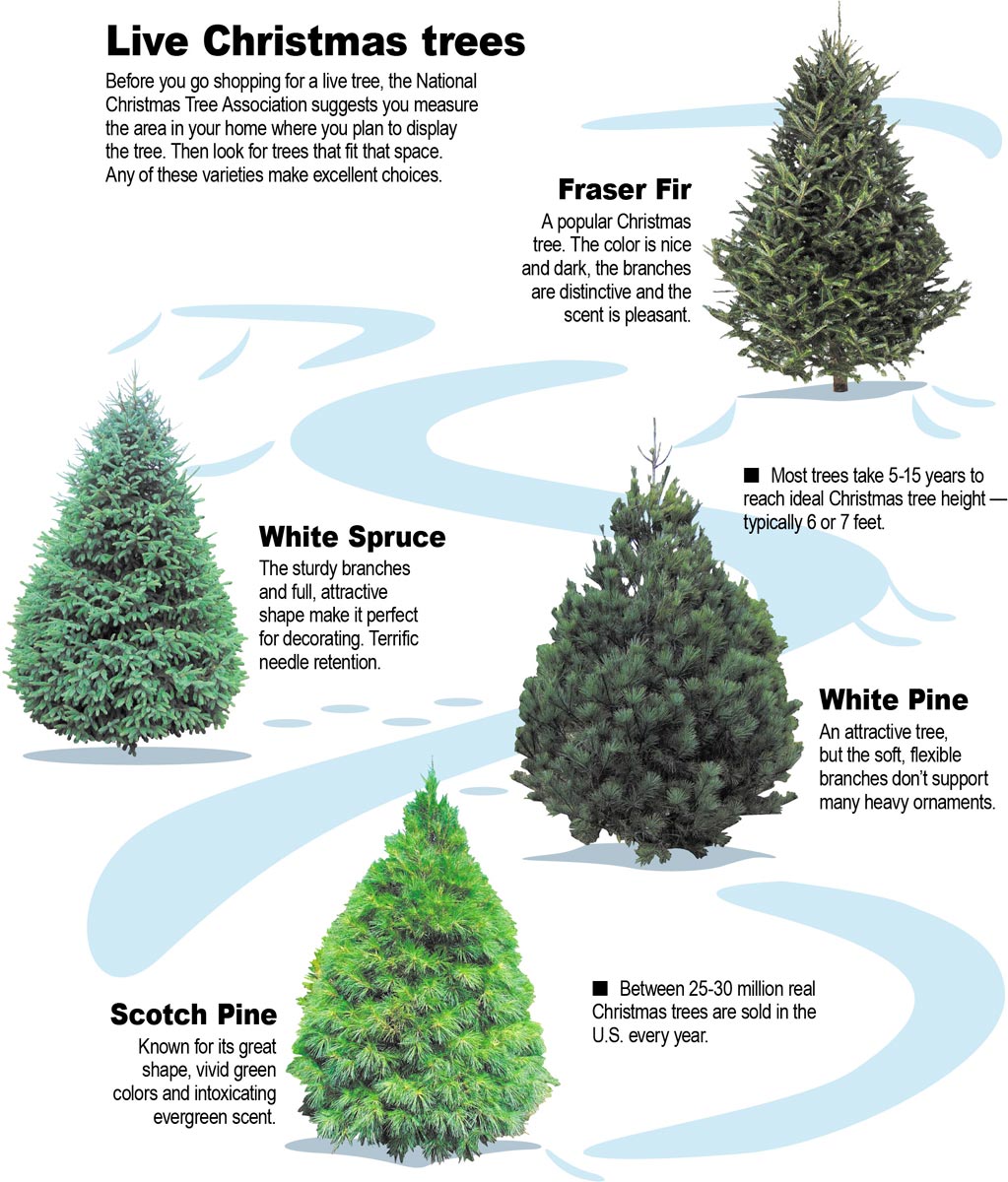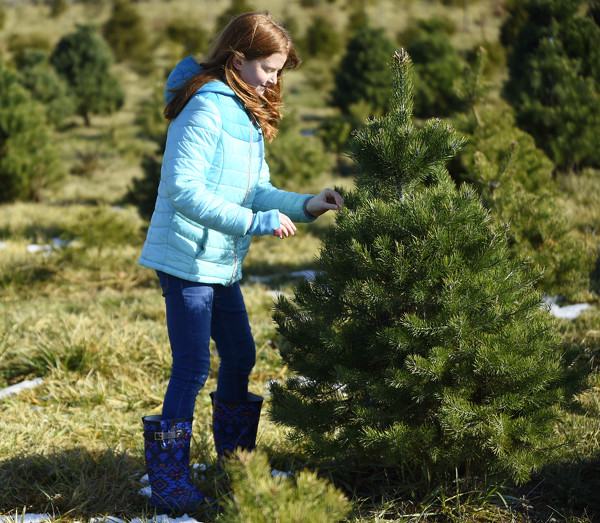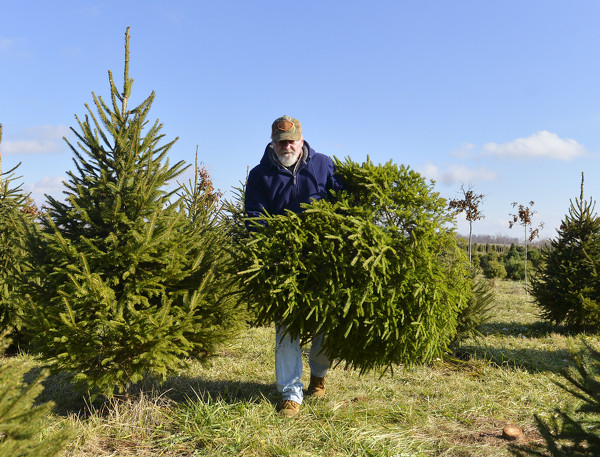
Pat Sudhoff nets a Christmas tree for Pat and Dale Ford on Friday afternoon at Sudhoff Tree Farm in Fort Recovery.
FORT RECOVERY - Freshly decorated Christmas trees are a common sight this time of year, but what does it take to get an evergreen from farm to family room?
Pat Sudhoff, owner of Sudhoff's Tree Farm and Produce near Fort Recovery, said Christmas trees are grown as crops on a farm just like corn or wheat. The 63-year-old farmer estimates he has about 10,000 ornamental, shade and Christmas trees growing on his property, and about half are Christmas trees.
Sudhoff's Tree Farm and Produce has grown pick- and cut-your-own Christmas trees since 1999. The farm has been in the same family for more than 150 years, and Sudhoff plans to pass it down to his son, Kyle, in the spring after he retires.
Kyle Sudhoff will be the fifth-generation owner of the farm, where he also grows produce and sells fresh eggs. His other son, Tyler, operates Coverall Tree Service on the same land.
Sudhoff grows five varieties of Christmas trees - Scotch pine, white pine, Norway spruce, white spruce and some blue spruce. All take at least five years to grow, Sudhoff said, and that's for a tree around 5 feet tall. A taller tree of 7 to 8 feet will take seven years or longer to grow.
Sudhoff also sells pre-cut Fraser firs, which are imported from other states. Fraser firs are considered premium trees, he said, partially due to their taking longer to grow and not being able to be grown in Ohio. The trees take 10-12 years to mature and don't fare well in Ohio because the weather is too warm, he said.
The lifelong farmer gets the trees he grows from Michigan, and they arrive in small trays. The seedlings are put into a pot to grow for a year and are watered every other day.
After a year, the saplings are planted in the ground. The young trees will grow with the assistance of stakes to keep them straight.
Sudhoff said he tries to plant 1,000 trees each year to replace the ones harvested the season before. The farmer was able to plant only 800 in 2019 due to the weather turning warm and wet early in the spring.

Before you go shopping for a live tree, the National Christmas Tree Association suggests you measure the area in your home where you plan to display the tree. Then look for trees that fit that space.
Any of these varieties make excellent choices.
SOURCE: National Christmas Tree Association
Doug Hundley, a spokesperson with the National Christmas Tree Association, said Christmas trees are planted in March or April when the weather is still a bit wet because fields often are not irrigated.
Hundley and Sudhoff agreed Christmas tree farmers don't have much downtime from March through December. After planting, trees are fertilized and are usually trimmed or sheered in June or July.
Farmers have to deal with pest and weed management throughout the summer. Sudhoff said deer are the biggest pests year-round - he estimates he loses about $1,000 worth of trees to deer each year. By the time fall rolls around it's time to market and advertise the crop, and trees are harvested in the winter.
"The only downtime is in January and February, which you use to plan" for the next season, Hundley said.
Trees are treated for disease, insects and weeds similarly to other crops, Hundley said. However, one key difference between growing Christmas trees and growing other crops is the labor involved.
Christmas tree growers have to plant, fertilize, spray for insects and diseases, trim and harvest trees all by hand, Hundley said. Sudhoff and his sons trim their trees once a year, which he said is an all-consuming task until all 5,000 Christmas trees are trimmed.
"It's six weeks of nothing but trimming," he said. "This is labor intensive."
Hundley also noted the sustainability of Christmas tree farming. The land does not get plowed, so the risk of soil or water erosion is very low. Most growers maintain some sort of ground cover as well. And of course, more trees means more oxygen.
In addition, Christmas trees have only a third of the carbon footprint of a fake tree, Hundley said. If the tree is recycled into mulch or compost, its carbon footprint is 10 times less.
"We grow ground cover that isn't competitive with the trees, we use integrated pest management," he said. "There's (less) use of chemicals and insecticides" and fields are designed to have beneficial plants and insects that will keep other harmful species out.
Although the labor required may be high, the return on investment can be high as well, Hundley said. It all depends on how many trees are planted each year.

Lucy Fennig, 12, checks out one of many pines in the field at Sudhoff Tree Farm on Friday in Fort Recovery.
Since no shortcut can speed up the number of trees available, once planting is completed each season the number of trees available in the future is fixed.
The fixed nature of the supply of trees cuts both ways, according to the NCTA's website; if too many are planted, as was the case in the 1990s, they don't go away until they are harvested and the oversupply pushes prices downward.
If the supply is tight due to market demand, growers cannot have more trees available until they are planted and grown in future years, causing more aggressive buying.
"It's profitable if you don't get caught in a downturn and prices are low," Hundley said.
Several other area Christmas tree farms have closed in the last decade, and as a result Sudhoff said his farm has been swamped with customers in recent years. However, while it's good to see demand high it also means fewer Christmas-ready trees are available.
Busy seasons lead to trees that are not as tall for the next season, Sudhoff said. Since the trees take at least five years to grow, a busy season the year before could mean the next year's harvest won't yield as many harvestable trees because they are still young.
In 2019, Sudhoff said he has barely had any trees that were 6 feet tall, and this year he said he was lucky to get a tree 7 feet tall due to the demand from last year. As a result, Sudhoff said sales are down slightly this year because they don't have the height customers want. He estimated he'll sell between 300-400 fresh and pre-cut Christmas trees this year.
According to NCTA's 2019 Christmas season consumer survey, 26.2 million real Christmas trees were purchased in 2019. Choose-and-cut farms, such as Sudhoff's, made up 32% of sales last year.
However, Sudhoff said he did see interest earlier than usual from consumers this year. His peak season typically runs from Black Friday through the second week of December, but this year some customers came earlier.
The pandemic may be pushing some to purchase a real Christmas tree when they may not have otherwise. With many people spending more time at home, people might have more time to water a fresh-cut tree. It's also a safer way to create special memories.
Sudhoff said one of the benefits of choosing and cutting your own Christmas tree is the experience. When families and individuals come to his farm, they can borrow a handsaw to cut down their own tree after carefully pacing the rows of evergreens. People can sip on hot chocolate and browse the crafts that Sudhoff's nephew creates, or pick one of the farm's hand-made wreaths.

Dale Ford carries the Christmas tree his wife, Pat, selected on Friday at Sudhoff Tree Farm.
"It's something they can do together outside," he said.
For more information on Christmas tree care tips, recycling, statistics and more visit https://realchristmastrees.org.
Sudhoff's Tree Farm and Produce is located at 6314 State Route 49, Fort Recovery. For more information, visit the Facebook page @SudhoffsTreeFarmAndProduce or call 419-942-1039.


